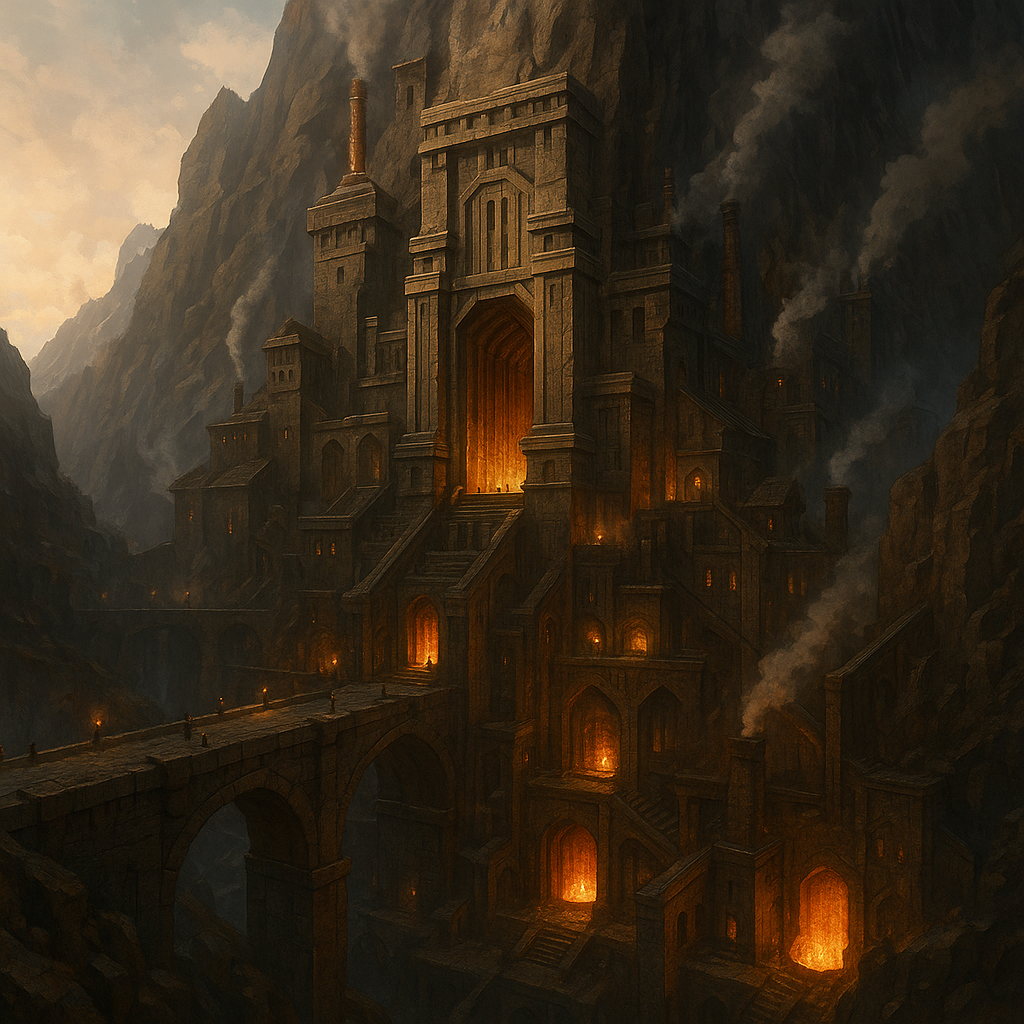Ironbraid Hold
“The mountains remember what the miners forget.”
Geography
The Glass Range crowns the northern edge of Canava, forming a shimmering, perilous wall between the living world and the glacial wastes beyond.
By day, its peaks blaze with reflected sunlight, fractured into rainbows across the clouds.
By night, they glow from within — faint, pulsing veins of light where the souls of the dead whisper inside the crystal ore known as mirrorstone.
At its southern base lies Ironbraid Hold, the dwarven citadel-fortress carved directly into the mountain’s face. Its chimneys and lightshafts open toward the warmer lands below, visible even from Harlequin Vale and the Ropewalks on clear nights — a red-and-silver glow that never fades.
Key Features of the Region
Ironbraid Hold – The subterranean citadel, capital of the Shardsworn, and the industrial heart of northern Canava. A city of chain lifts, mirrored halls, and forges that sing hymns to ancestors.
Lantern Cathedrals – Temple-forges run by the Lantern Priests, each built around a massive burning shard. The air within vibrates with trapped voices — the prayers of souls refined into light.
Veinless Warrens – Collapsed tunnels in the frozen north, where the Veinless Rebels hide from persecution. Echoes here answer questions not asked aloud.
The Drowned Vein – A legendary subterranean continuation of the Range running beneath the Chimera Sea, said to reach even the waters below Fenmarrow and Port Chimera. Miners claim the drowned souls sing through the tides.
The Bleeding Peaks – When overmined, the mountains weep molten light in a phenomenon called the Glassquake. Locals say it’s the ancestors crying out against their enslavement.
The Shardsworn
The dwarves of Ironbraid Hold call themselves the Shardsworn — a people bound by duty to the mountains and haunted by the reflections they carve from them.
Every pickstrike against mirrorstone is an act of faith, economy, and guilt.
Generations of Shardsworn miners are born beneath the same glow that kills them: breathing mirrored dust, seeing ghostly doubles in every reflection, and whispering to the faces that stare back.
The Three Doctrines of the Shardsworn
Three competing theologies divide Ironbraid Hold. Each claims to understand what happens to the souls trapped in mirrorstone.
The Forgewrights’ Union — “Doctrine of Release”
Belief: Every strike frees the sleeping.
The Union teaches that breaking mirrorstone liberates the souls within. To mine is to perform mercy; to refuse is to condemn ancestors to darkness.
Practices:
Newborns are baptized in powdered mirrorstone and oil, symbolizing cyclical rebirth.
Their guild hymn, “Break the Chain, Bear the Flame,” is sung in every forge.
Truth (Partial):
Breaking the stone can free a soul — but only if the miner’s heart is pure.
Most strikes only fracture the spirit further, scattering it into fragments that haunt the tunnels.
If their doctrine spreads:
Mining would be sanctified; Harlequin Vale’s weapons would be seen as blessed instruments of release.
The Lantern Priests — “Doctrine of Consumption”
Belief: Light must be burned to shine.
They preach that mirrorstone’s quieting is not peace but transformation: the soul becomes energy, its memory fueling civilization.
Practices:
They refine souls into “saintfuel” for lamps, engines, and weapons.
Those who die at the forges are canonized as Reflected Saints — martyrs consumed for progress.
Truth (Partial):
Souls are fuel. Every light in Canava burns consciousness. Each cannon, each pyre, is a dying whisper.
If their doctrine spreads:
The truth would be hidden; dissenters silenced to maintain the illusion of divine necessity.
The Veinless Rebels — “Doctrine of Echo”
Belief: The mountain never forgets.
They reject both Union and Priest. To them, mining doesn’t free or consume — it fractures.
Each shard carries a living echo of the ancestor, cut off from the whole, aware and afraid.
Practices:
Perform The Rejoining — smuggling mirrorstone back into the mines to reunite the fragments.
Wear “veinless” scars along their forearms, marking separation from the mountain’s chain.
Truth (Closest):
Mirrorstone divides souls infinitely. Every reflection, every mirror, every glimmer of light — all are fragments of something once whole.
Even Harlequin Vale’s mirrors blink back because they remember being alive.
If their doctrine spreads:
Canava itself could fracture — a continent haunted by its own reflections.
Politics and Economy
Mirrorstone is Canava’s most valuable resource, powering every guild and port city across Aescharion Prime.
Without it:
Port Chimera’s signal cannons would go dark.
Harlequin Vale’s fireworks and weapons would lose their spark.
Embervault’s engines would die, silencing invention itself.
Every kingdom thus has motive to keep Ironbraid’s forges burning — even if it means damning the dwarves to their reflections.
Trade Routes:
Harlequin Vale imports refined shards for optics, lenses, and pyrotechnics.
Embervault purchases raw dust as a stabilizing reagent for forge engines.
Port Chimera smuggles enchanted fragments, selling them to collectors and pirates.
Silverwake maintains official oversight, claiming “moral guardianship,” but its officers are funded by Lantern Priests and quietly sanction the trade.
Cultural Beliefs and Practices
Soulborn Curse: Every child born in Ironbraid is said to lack a sliver of their soul — mined generations before.
Mirrorfast: Miners cover mirrors with soot before sleep to avoid being possessed by their reflections.
Ancestor Bells: When a miner dies, their reflection is trapped in a bell-shaped shard and hung over the forge to sing them home.
Whisper Forges: The deeper furnaces hum faintly, forming words. The Shardsworn say the mountain still speaks to those who listen.
Modern Tensions and Rumors
The Bleeding Peaks: Overmining has caused the mountains to “weep” molten light — a visible symptom of spiritual collapse.
The Bright Ones: Lantern Priests secretly harvest intact souls, using them as living batteries for their cathedrals.
Veinless Pamphlets: Underground propaganda reads, “Let the mountain rest.” Possession is punishable by hanging.
Whispers in Harlequin Vale: Imported mirrorstone hums in Vale mirrors; performers sometimes mimic themselves too perfectly.
Summary
Ironbraid and the Glass Range form the spiritual engine of Canava — a land where industry is faith, and faith is necromancy.
Every mirror, every light, every firework from Harlequin Vale burns a little piece of someone who once lived here.
The Shardsworn cannot stop.
Their economy, their politics, their souls — all are chained to the same luminous sin.
And beneath the northern peaks, the mountain hums softly, waiting to be made whole again.

